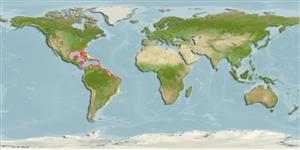Teleostei (teleosts) >
Carangiformes (Jacks) >
Carangidae (Jacks and pompanos) > Caranginae
Etymology: Selene: Greek, selene = moon (Ref. 45335).
Eponymy: Dr Patrick Browne (1720–1790) was an Irish physician, botanist and historian. [...] (Ref. 128868), visit book page.
More on author: Cuvier.
Issue
Author may probably be Cuvier 1816.
Environment: milieu / climate zone / depth range / distribution range
Ecology
Marine; demersal. Tropical
Western Atlantic Ocean.
Size / Weight / Age
Maturity: Lm ? range ? - ? cm
Max length : 34.1 cm TL male/unsexed; (Ref. 122735); common length : 20.0 cm TL male/unsexed; (Ref. 5217); max. published weight: 119.30 g (Ref. 118626)
Adults occur over continental shelves (Ref. 5217). No real fishery (Ref. 51310). Edibility not known (Ref. 51310).
Life cycle and mating behavior
Maturity | Reproduction | Spawning | Eggs | Fecundity | Larvae
Smith-Vaniz, W.F., 2003. Carangidae. Jacks and scads (bumpers, pompanos, leatherjacks, amberjacks, pilotfishes, rudderfishes). p. 1426-1468. In K.E. Carpenter (ed.) FAO species identification guide for fishery purposes. The living marine resources of the Western Central Atlantic. Vol. 3: Bony fishes part 2 (Opistognathidae to Molidae), sea turtles and marine mammals. (Ref. 51310)
IUCN Red List Status (Ref. 130435: Version 2024-1)
Threat to humans
Harmless
Human uses
Fisheries: subsistence fisheries
Tools
Special reports
Download XML
Internet sources
Estimates based on models
Preferred temperature (Ref.
123201): 22.4 - 27.5, mean 25.9 °C (based on 164 cells).
Phylogenetic diversity index (Ref.
82804): PD
50 = 0.5039 [Uniqueness, from 0.5 = low to 2.0 = high].
Bayesian length-weight: a=0.01479 (0.00900 - 0.02430), b=2.85 (2.71 - 2.99), in cm total length, based on LWR estimates for this species & (Sub)family-body (Ref.
93245).
Trophic level (Ref.
69278): 4.0 ±0.7 se; based on size and trophs of closest relatives
Generation time: 1.8 ( na - na) years. Estimated as median ln(3)/K based on 2
growth studies.
Resilience (Ref.
120179): High, minimum population doubling time less than 15 months (Preliminary K or Fecundity.).
Fishing Vulnerability (Ref.
59153): Low vulnerability (24 of 100).
